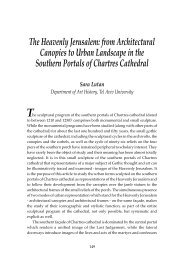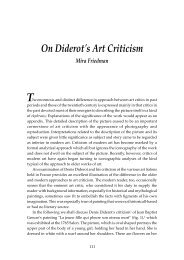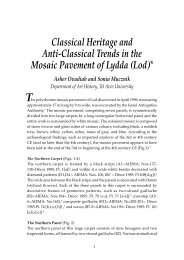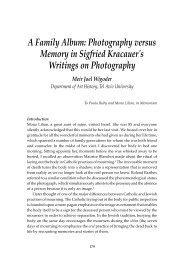The Non-presence of People in David Hockney's Paintings of ...
The Non-presence of People in David Hockney's Paintings of ...
The Non-presence of People in David Hockney's Paintings of ...
You also want an ePaper? Increase the reach of your titles
YUMPU automatically turns print PDFs into web optimized ePapers that Google loves.
THE NON-PRESENCE OF PEOPLE IN DAVID HOCKNEY'S PAINTINGS<br />
<strong>The</strong> <strong>Non</strong>-<strong>presence</strong> <strong>of</strong> <strong>People</strong> <strong>in</strong><br />
<strong>David</strong> <strong>Hockney's</strong> Pa<strong>in</strong>t<strong>in</strong>gs <strong>of</strong><br />
Nouveau Riche Houses<br />
Revital Grün Silverman<br />
Tel Aviv University<br />
<strong>The</strong> house, the residence, is the only rampart aga<strong>in</strong>st the dread <strong>of</strong><br />
noth<strong>in</strong>gness, darkness and the obscurity <strong>of</strong> the past… Man’s<br />
identity is thus residential… <strong>The</strong> man without a home is a potential<br />
crim<strong>in</strong>al<br />
Immanuel Kant 1<br />
In this article I would like to discuss two forms <strong>of</strong> spaces <strong>of</strong> <strong>Hockney's</strong><br />
nouveau-riche’s series: on the one hand, the space <strong>of</strong> pa<strong>in</strong>t<strong>in</strong>g – the space <strong>in</strong>side<br />
the <strong>in</strong>ner frame and the space between the <strong>in</strong>ner and external frame; and on<br />
the other hand, the space <strong>of</strong> the nouveau-riche house that is divided <strong>in</strong>to two<br />
k<strong>in</strong>ds - those that are entirely devoid <strong>of</strong> people and those that feature a<br />
presentation <strong>of</strong> the collectors. In this article I discuss the perception <strong>of</strong> space <strong>in</strong><br />
the “empty” houses, through two prom<strong>in</strong>ent works from the series: A Bigger<br />
Splash (Fig. 1) and A Lawn Spr<strong>in</strong>kler (Fig. 2). Although it is widely accepted,<br />
that the collectors are not present <strong>in</strong> the works, I argue that even when they are<br />
not explicitly represented there is a trace <strong>of</strong> the collectors.<br />
<strong>The</strong> theme <strong>of</strong> nouveau-riche houses has occupied <strong>David</strong> Hockney s<strong>in</strong>ce the<br />
sixties, a short time after his move from northern England to California, <strong>in</strong><br />
1964. Hockney escorted the art dealer John Kasm<strong>in</strong>, to a series <strong>of</strong> bus<strong>in</strong>ess<br />
meet<strong>in</strong>gs <strong>in</strong> various art collectors’ homes, <strong>in</strong> the suburbs <strong>of</strong> Los Angeles.<br />
Through these meet<strong>in</strong>gs he learned to know those houses. As a foreigner,<br />
Hockney created an eccentric and unique image <strong>of</strong> his adopted home; a theme<br />
that made its debut <strong>in</strong> the sixties, when he began to pa<strong>in</strong>t the suburbs <strong>of</strong> Los<br />
Angeles, organiz<strong>in</strong>g them as a pla<strong>in</strong> accord<strong>in</strong>g to a geometrical, straight and<br />
rigorous pattern. 2<br />
103
REVITAL SILVERMAN<br />
Fig. 1: <strong>David</strong> Hockney, A Bigger Splash, 1967. Acrylic on canvas, 244x244,<br />
Marchioness <strong>of</strong> Duffer<strong>in</strong> and Ava, London.<br />
<strong>The</strong> housepipe <strong>in</strong> A Lawn Spr<strong>in</strong>kler and the stepp<strong>in</strong>g stone <strong>in</strong> A Bigger Splash,<br />
<strong>in</strong>troduces the spectator <strong>in</strong>to the depth <strong>of</strong> the picture. Any feel<strong>in</strong>g <strong>of</strong> depth<br />
disappears because the lawn <strong>in</strong> the front and back plane is treated with the<br />
same <strong>in</strong>tensity. <strong>The</strong>re is no blurr<strong>in</strong>g <strong>of</strong> color <strong>in</strong> the distance; no depth <strong>in</strong> the<br />
depiction <strong>of</strong> water. <strong>The</strong> water and the splash belong to the same reality but are<br />
depicted as different ones; no shadow exists, except that <strong>of</strong> the chair <strong>in</strong> A Bigger<br />
Splash. <strong>The</strong> pa<strong>in</strong>ted frame, <strong>in</strong> both pictures, creates the awareness to the twodimensionality<br />
<strong>of</strong> the canvas.<br />
<strong>The</strong>se pa<strong>in</strong>t<strong>in</strong>gs are among the last <strong>in</strong> which Hockney used a frame around<br />
the image - whether pa<strong>in</strong>ted or left as bare marg<strong>in</strong>s <strong>of</strong> canvas - which is the<br />
space between the <strong>in</strong>ner and external frame. Hockney expla<strong>in</strong>s the white stripe:<br />
104
THE NON-PRESENCE OF PEOPLE IN DAVID HOCKNEY'S PAINTINGS<br />
Fig. 2: <strong>David</strong> Hockney, A Lawn Spr<strong>in</strong>kler, 1967. Acrylic on canvas, 122x122,<br />
Collection <strong>of</strong> Mr. and Mrs. J. G. Studholme, London.<br />
‘I used borders around an image a lot, from about 1964 to 1967. This wasn’t<br />
just a fram<strong>in</strong>g device. It started <strong>of</strong>f as a formal device… it seemed to me that if<br />
I cut that picture <strong>of</strong>f there, it became more conventional, and I was a little<br />
frightened <strong>of</strong> that then’. 3 Both works comprise a flat square with white borders<br />
that emphasize the flatness <strong>of</strong> the canvas itself - the two-dimensionality that is<br />
so <strong>in</strong>dispensable to modern pa<strong>in</strong>t<strong>in</strong>g, as it is to Polaroid photography.<br />
<strong>The</strong> white strip can be related to the space between two borders, the way<br />
that Samuel Weber describes the symbolic structure <strong>of</strong> psychic anxiety itself:<br />
‘Anxiety is perhaps what one feels when the world reveals itself to be caught<br />
up <strong>in</strong> the space between two frames: a doubled frame, or one that is split’. 4<br />
This <strong>in</strong>-between space, a third space, is the place where th<strong>in</strong>gs are not connected;<br />
105
REVITAL SILVERMAN<br />
it is not just between borders but it is the place itself that is not self-evident,<br />
that causes anxiety, because the object fac<strong>in</strong>g one is not clear. whereas Weber’s<br />
theory belongs to the psychoanalytic discourse, the follow<strong>in</strong>g theories, that I<br />
shall develop here belong to the sociological and the philosophical discourse.<br />
In Frame Analysis 5 by the American sociologist Erv<strong>in</strong>g G<strong>of</strong>fman, there is a<br />
dist<strong>in</strong>ction between two broad classes <strong>of</strong> primary frameworks: natural and<br />
social. Nathalie He<strong>in</strong>ich applies this theory to the bullfight <strong>in</strong> her article<br />
“Fram<strong>in</strong>g the bullfight: Aesthetics versus ethics”, 6 as an example <strong>of</strong> the social<br />
and the transformed frame: In opposition to the “savage” un<strong>in</strong>tended and<br />
unformalized confrontation <strong>of</strong> a bull and a man <strong>in</strong> a field, which would<br />
constitute a primary frame, there exists the social as the transformed frame.<br />
<strong>The</strong> key (<strong>of</strong> performance) and the fabrication (formal, regulated ceremony) are<br />
two types <strong>of</strong> transformed frame. He<strong>in</strong>ich claims that transformed frames are<br />
characterized by the existence <strong>of</strong> brackets. This spatial brackets delimit several<br />
levels <strong>of</strong> participation: the walls <strong>of</strong> the arena isolate, all the participants<br />
(transformed frame) from the external world (primary frame). <strong>The</strong> first barrier<br />
isolates from the public all the personnel (actors, doctors, etc.); the second barrier<br />
isolates, from the alley between those two barriers reserved for the personnel,<br />
the team made up by the matadors and toreadors, picadors and horses,<br />
banderilleros and <strong>of</strong> course, the bull..I claim that as Hockey’s frame, ‘<strong>The</strong>se<br />
brackets’, <strong>in</strong> He<strong>in</strong>ich words, ‘which are neither <strong>in</strong>side, nor outside, like the<br />
frame <strong>of</strong> a picture, become part <strong>of</strong> an action as soon as an actor transgresses it,<br />
when <strong>in</strong> flee<strong>in</strong>g or <strong>in</strong> pursuit outside the arena’. 7<br />
Two philosophers have followed the changes <strong>in</strong> the status <strong>of</strong> the frame<br />
(Immanuel Kant and Jacques Derrida). Kant considers the necessary conditions<br />
for someth<strong>in</strong>g to be beautiful:<br />
Even that we call “ornaments” [parerga], those th<strong>in</strong>gs which do<br />
not belong to the complete representation <strong>of</strong> the object <strong>in</strong>ternally<br />
as elements, but only externally as complements, and which<br />
augment the satisfaction <strong>of</strong> taste, do not only by their forms; as,<br />
for example the frames <strong>of</strong> pictures or the draperies <strong>of</strong> statues or<br />
the colonnades <strong>of</strong> places. But if the ornament does not itself consist<br />
<strong>in</strong> beautiful form and if it is used as a golden frame is used, merely<br />
to recommend the pa<strong>in</strong>t<strong>in</strong>g by its charm, it is then called f<strong>in</strong>ery<br />
and <strong>in</strong>jures genu<strong>in</strong>e beauty. 8<br />
Frames have no value as themselves, accord<strong>in</strong>g Kant, but are <strong>in</strong>tended to draw<br />
attention to the creation itself, to be supplements. As such, claims Jacques<br />
106
THE NON-PRESENCE OF PEOPLE IN DAVID HOCKNEY'S PAINTINGS<br />
Derrida <strong>in</strong> <strong>The</strong> truth on pa<strong>in</strong>t<strong>in</strong>g, <strong>in</strong> the section that deals with Kant: ‘You have<br />
to know what <strong>in</strong>tr<strong>in</strong>sically concerns the value “beauty” and what rema<strong>in</strong>s<br />
external to your immanent sense <strong>of</strong> beauty. This requirement presupposes a<br />
discourse on the limit between the <strong>in</strong>side and outside <strong>of</strong> the art object, here a<br />
discourse on the frame’. 9 <strong>The</strong>se ornaments, cont<strong>in</strong>ues Derrida, work for Kant<br />
as <strong>in</strong>ner and outer borders. <strong>The</strong>y act as supplements - they are outside, but<br />
they are not the th<strong>in</strong>gs that are outside, because they are the borders. However,<br />
the supplement has a potential for greater importance than the work itself,<br />
s<strong>in</strong>ce without it one would not know where the creation beg<strong>in</strong>s and ends, or<br />
even the fact that one is stand<strong>in</strong>g <strong>in</strong> front <strong>of</strong> a creation.<br />
In addition to the problem <strong>of</strong> the absence <strong>of</strong> depth <strong>in</strong> the picture, discussed<br />
above, the disappearance <strong>of</strong> the body is another question that arises from those<br />
pa<strong>in</strong>t<strong>in</strong>gs. Both the water and the glass act as screens that conceal the human<br />
body: the bodies <strong>of</strong> the collectors <strong>in</strong> A Lawn Spr<strong>in</strong>kler, and the body <strong>of</strong> the diver<br />
<strong>in</strong> A Bigger Splash. In the former, the glass w<strong>in</strong>dow is simultaneously transparent<br />
- it is possible to see the armchair and other furniture <strong>in</strong>side the house, and<br />
opaque-mirror<strong>in</strong>g the outside view.<br />
Rosal<strong>in</strong>d Krauss notes that a grid [<strong>in</strong> our case the bars over the w<strong>in</strong>dows]<br />
conveys one <strong>of</strong> the basic laws <strong>of</strong> knowledge - separation <strong>of</strong> the perceptual screen<br />
from that <strong>of</strong> the “real” world. 10 <strong>The</strong> w<strong>in</strong>dow, she cont<strong>in</strong>ues, is experienced as<br />
simultaneously transparent and opaque. As a transparent vehicle, it is that<br />
which admits light - or spirit - <strong>in</strong>to the <strong>in</strong>itial darkness <strong>of</strong> the room. But if glass<br />
transmits, it also reflects. And so the w<strong>in</strong>dow is experienced as a mirror -<br />
someth<strong>in</strong>g that freezes and locks the self <strong>in</strong>to the space <strong>of</strong> its own reduplicated<br />
be<strong>in</strong>g; the bars <strong>of</strong> the w<strong>in</strong>dow - the grid - are what help us to see, to focus.<br />
Lefebvre cont<strong>in</strong>ues this l<strong>in</strong>e <strong>of</strong> thought when he speaks <strong>of</strong> a ‘double<br />
illusion’, 11 each side <strong>of</strong> which refers back to the other, re<strong>in</strong>forces the other, and<br />
hides beh<strong>in</strong>d the other. <strong>The</strong> two aspects are the illusion <strong>of</strong> transparency on the<br />
one hand and the illusion <strong>of</strong> opacity, or “realistic” illusion, on the other. In the<br />
illusion <strong>of</strong> transparency, he claims, space appears as lum<strong>in</strong>ous, as <strong>in</strong>telligible,<br />
as giv<strong>in</strong>g free re<strong>in</strong> for action. <strong>The</strong> realistic illusion is closer to (naturalistic and<br />
mechanistic) materialism. Rather than be<strong>in</strong>g mutually antagonistic, each illusion<br />
embodies and nourishes the other. <strong>The</strong> oscillation between the two, and the<br />
result<strong>in</strong>g flicker<strong>in</strong>g effect, are thus just as important as either <strong>of</strong> the illusions<br />
considered <strong>in</strong> isolation.<br />
Krauss’ argument discussed above relates also to the idea <strong>of</strong> public and<br />
private space: the 20 th century has been witness to the build<strong>in</strong>g <strong>of</strong> such private<br />
homes as “Prairie House” (1900), designed by Frank Lloyd Wright and<br />
107
REVITAL SILVERMAN<br />
published <strong>in</strong> the Ladies’ Home Journal. 12 As the ideal design <strong>of</strong> a house suggest<strong>in</strong>g<br />
absolute privacy, the w<strong>in</strong>dow open<strong>in</strong>gs fac<strong>in</strong>g the street are relatively small,<br />
and are located high up, under the eaves. In contrast, “Farnsworth House”<br />
(1946-51), Ill<strong>in</strong>ois, designed by Ludwig Mies van der Rohe, <strong>of</strong>fers the opposite<br />
approach, which Elizabeth Gordon describes as ‘a one room house that is<br />
noth<strong>in</strong>g but a glass cage on stilts’. ❩❭ Gordon perceives this house as a home that<br />
can not be shielded from the public gaze. Edith Farnsworth, owner <strong>of</strong> the house,<br />
herself noted, ‘the house is transparent, like an X-ray’. 14<br />
<strong>The</strong> well-groomed facades <strong>of</strong> the collector’s houses that Hockney depicts<br />
require us to keep a distance, while the large glass w<strong>in</strong>dows and the pool,<br />
which are situated outdoors, prevent an image <strong>of</strong> absolute privacy. Mike Davies<br />
observes that ‘security has less to do with personal safety than with the degree<br />
<strong>of</strong> personal <strong>in</strong>sulation’. 15<br />
In A Bigger Splash another problem arises: that <strong>of</strong> space <strong>in</strong> time; or, <strong>in</strong> other<br />
words, the freez<strong>in</strong>g <strong>of</strong> time that <strong>David</strong> Hockey recounts:<br />
I loved the idea <strong>of</strong> pa<strong>in</strong>t<strong>in</strong>g this th<strong>in</strong>g that lasts for two seconds, it<br />
takes me two weeks to pa<strong>in</strong>t this event that lasts for two seconds.<br />
<strong>The</strong> effect <strong>of</strong> it as it got bigger was more stunn<strong>in</strong>g - everybody<br />
knows a splash can’t be frozen <strong>in</strong> time, it doesn’t exist, so when<br />
you see it like that <strong>in</strong> a pa<strong>in</strong>t<strong>in</strong>g it’s even more strik<strong>in</strong>g than <strong>in</strong> a<br />
photograph, because you know a photograph took a second to<br />
take, or less. In fact if it’s a splash and there’s no blur <strong>in</strong> it, you<br />
know it took a sixtieth <strong>of</strong> a second, less time than the splash existed<br />
for. <strong>The</strong> pa<strong>in</strong>t<strong>in</strong>g took much longer to make than the splash existed<br />
for, so it has a very different effect on the viewer. When the pa<strong>in</strong>t<strong>in</strong>g<br />
was exhibited <strong>in</strong> Paris <strong>in</strong> 1974, I had them po<strong>in</strong>t one <strong>of</strong> the lights<br />
right on the splash itself, so it was even whiter. 16<br />
Hockney froze the moment <strong>of</strong> the splash. 17 It is visible as a trace <strong>of</strong> the unseen<br />
diver. <strong>The</strong> trace has no <strong>presence</strong>, notes Derrida. Like a signifier, it refers to<br />
someth<strong>in</strong>g that is absent, and the gap between traces refers to someth<strong>in</strong>g that<br />
is miss<strong>in</strong>g provid<strong>in</strong>g a sense <strong>of</strong> ‘essence’. Accord<strong>in</strong>g to Vasseleu, Irigaray, writ<strong>in</strong>g<br />
on this suspension; mentions the ‘forgotten vag<strong>in</strong>a’, when she places a different<br />
emphasis on the ‘detour/passage’ <strong>of</strong> metaphor by relat<strong>in</strong>g it to the passage<br />
between the artificially lit <strong>in</strong>terior and the purity <strong>of</strong> the outside light, <strong>in</strong> Plato’s<br />
famous cave allegory. Irigaray contends that it is precisely the metaphoric<br />
omission <strong>of</strong> the transition that allows such movement. <strong>The</strong> ‘forgotten vag<strong>in</strong>a’<br />
108
THE NON-PRESENCE OF PEOPLE IN DAVID HOCKNEY'S PAINTINGS<br />
is the ‘passage that is miss<strong>in</strong>g, left on the shelf, between the outside and the<br />
<strong>in</strong>side, between the plus and the m<strong>in</strong>us’. 18<br />
Irigaray names ‘<strong>in</strong>scriptional space’, 19 accord<strong>in</strong>g to Judith Butler, as the<br />
specular surface that receives the marks <strong>of</strong> a mascul<strong>in</strong>e signify<strong>in</strong>g act only to<br />
give back a (false) reflection and guarantee <strong>of</strong> phallogocentric self-sufficiency,<br />
without mak<strong>in</strong>g any contribution <strong>of</strong> its own. This <strong>in</strong>scriptional space makes its<br />
appearance <strong>in</strong> Plato’s “Timaeus” as the receptacle (Khora). This receptacle is<br />
not a metaphor based on likeness to a human form, but a disfiguration that<br />
emerges at the boundaries <strong>of</strong> the human, both as its very condition and as the<br />
<strong>in</strong>sistent threat <strong>of</strong> its deformation. It cannot take a form, a morphe and, <strong>in</strong> that<br />
sense it cannot be a body.<br />
Derrida sees this <strong>in</strong>scriptional space as a third gender/genre that cannot<br />
(she/it) be called by name. He expla<strong>in</strong>s that there is a preference for the <strong>presence</strong><br />
<strong>of</strong> speech over writ<strong>in</strong>g. Speech represents essence, orig<strong>in</strong>, it arrives without<br />
mediation and is exact, true and correct; whereas writ<strong>in</strong>g conta<strong>in</strong>s tears, cracks<br />
and voids. In <strong>in</strong>scription there is a process <strong>of</strong> <strong>in</strong>citement, movement, removal<br />
<strong>of</strong> the basic categories, through which we deliver <strong>in</strong>formation: ‘<strong>The</strong> problematic<br />
<strong>of</strong> the place - the third irreducible class - all these th<strong>in</strong>gs “require” that we<br />
def<strong>in</strong>e the orig<strong>in</strong> <strong>of</strong> the world as trace, that is, a receptacle. It is a matrix, womb,<br />
or receptacle that is never and nowhere <strong>of</strong>fered up <strong>in</strong> the form <strong>of</strong> <strong>presence</strong>...’. 20<br />
<strong>The</strong> terms ‘receptacle’, ‘matrix’, ‘mother’, ‘nurse’, cause us to th<strong>in</strong>k <strong>of</strong> a space<br />
that conta<strong>in</strong>s th<strong>in</strong>gs. <strong>The</strong> vag<strong>in</strong>al absence space implies that the place is a<br />
fem<strong>in</strong><strong>in</strong>e place. Khora is a place, a hole, a puncture, receptacle, womb. <strong>The</strong><br />
womb has no quality <strong>of</strong> its own, it is empty, a miss<strong>in</strong>g <strong>presence</strong>, the ‘différance’,<br />
suspension, space; it accepts, but owns noth<strong>in</strong>g.<br />
<strong>The</strong> water <strong>in</strong> Hockey’ pa<strong>in</strong>t<strong>in</strong>gs is a screen that represents the body that can<br />
not be achieved. <strong>The</strong> diver is not seen, and the splash emphasizes what Merleau-<br />
Ponty calls ‘<strong>The</strong> scandal <strong>of</strong> depth’, i.e., the capacity <strong>of</strong> depth to hide th<strong>in</strong>gs<br />
from us, to swallow them up. 21 He claims that the picture is a flat th<strong>in</strong>g,<br />
contriv<strong>in</strong>g to give us what we would see <strong>in</strong> the <strong>presence</strong> <strong>of</strong> th<strong>in</strong>gs by <strong>of</strong>fer<strong>in</strong>g<br />
sufficient diacritical signs, through height and width, <strong>of</strong> the miss<strong>in</strong>g<br />
dimension. 22 Depth is a third dimension derived from the other two. Th<strong>in</strong>gs<br />
encroach upon one another because they are outside one another accord<strong>in</strong>g<br />
Merleoq-Ponf. <strong>The</strong> pro<strong>of</strong> <strong>of</strong> this is that one can see depth <strong>in</strong> a pa<strong>in</strong>t<strong>in</strong>g, which<br />
everyone agrees has none and which organizes <strong>in</strong>to an illusion <strong>of</strong> an illusion.<br />
<strong>The</strong> Silueta Works by Ana Mendieta (Fig. 4), and the Portrait <strong>of</strong> the Gardener<br />
Vallier by Paul Cézanne (Fig. 3), I want to argue, are another example <strong>of</strong> the<br />
suspension that exists between real and illusionary space. In the portrait by<br />
109
REVITAL SILVERMAN<br />
Fig. 3: Paul Cézanne, Portrait <strong>of</strong> Gardner Vallier, 1906. Graphite and<br />
watercolor on paper, 48x31.5, the Berggruer Collection, on loan to<br />
the National Gallery, London.<br />
110
THE NON-PRESENCE OF PEOPLE IN DAVID HOCKNEY'S PAINTINGS<br />
Fig. 4: Ana Mendieta, Silueta Works <strong>in</strong> Iowa, 1976-78, color photograph,<br />
50.8x40.6, edition <strong>of</strong> 20. <strong>The</strong> Estate <strong>of</strong> Ana Mendieta and Galerie<br />
Lelong, New York.<br />
Cézanne, the blank spaces <strong>of</strong> a white page are not filled but surrounded by<br />
colours that signify the white beard and clothes <strong>of</strong> the gardener Vallier, and<br />
that take on the function <strong>of</strong> giv<strong>in</strong>g shape and sett<strong>in</strong>g it <strong>of</strong>f. Relat<strong>in</strong>g to the<br />
watercolors <strong>of</strong> the late years <strong>of</strong> Cézanne, Ponty notes, ‘space radiates around<br />
planes that cannot be assigned any place at all’. 23 Mendieta’s photographs<br />
function as documentation <strong>of</strong> her impressed body, testify<strong>in</strong>g that ‘Mendieta<br />
was there’, 24 while also record<strong>in</strong>g her total absence - they are but traces <strong>of</strong> traces,<br />
traces that evoke a strong sense <strong>of</strong> isolation, aloneness and lonel<strong>in</strong>ess.<br />
<strong>The</strong> splash <strong>in</strong> Hockney’s A Bigger Splash is the diver’s trace; it functions like<br />
the white left by Cézanne is the gardener’s body trace and Mendieta’s<br />
photographs are the traces <strong>of</strong> her body. In all three works the issue <strong>of</strong> orig<strong>in</strong>s<br />
becomes one <strong>of</strong> how - if at all- they can be commemoratively recalled. If,<br />
accord<strong>in</strong>g Derrida, ‘Everyth<strong>in</strong>g beg<strong>in</strong>s by referr<strong>in</strong>g back, that is to say, does<br />
not beg<strong>in</strong>’, everyth<strong>in</strong>g is <strong>in</strong> effect a memory trace; but <strong>of</strong> what, asks Edward S.<br />
Casey, if not <strong>of</strong> a beg<strong>in</strong>n<strong>in</strong>g then <strong>of</strong> an (absent) orig<strong>in</strong>? 25 Everyth<strong>in</strong>g beg<strong>in</strong>s by<br />
forgett<strong>in</strong>g the orig<strong>in</strong>: ‘<strong>The</strong> beg<strong>in</strong>n<strong>in</strong>g <strong>of</strong> Western thought’ accord<strong>in</strong>g Heidegger,<br />
‘is not the same as its orig<strong>in</strong>. <strong>The</strong> beg<strong>in</strong>n<strong>in</strong>g is, rather, the veil that conceals the<br />
111
REVITAL SILVERMAN<br />
orig<strong>in</strong> – <strong>in</strong>deed an unavoidable veil… <strong>The</strong> orig<strong>in</strong> keeps itself concealed <strong>in</strong> the<br />
beg<strong>in</strong>n<strong>in</strong>g’. 26<br />
<strong>The</strong> above discussed image <strong>of</strong> people <strong>in</strong> Hockney’s work, from full <strong>presence</strong><br />
till total disappearance, rem<strong>in</strong>ds us (as do the solitary figures <strong>in</strong> Cézanne’s<br />
and Mendieta’s works) Heidegger’s notion <strong>of</strong> Presence that is not itself<br />
someth<strong>in</strong>g <strong>in</strong> the present but rather 'the wholeness <strong>of</strong> life, achieved only <strong>in</strong><br />
death, when we are no longer ‘there’. 27 It is thus, <strong>in</strong> the words <strong>of</strong> Susan Best,<br />
‘not through our <strong>presence</strong>, but through our pass<strong>in</strong>g, that we are f<strong>in</strong>ally<br />
<strong>in</strong>dividuated and complete’. 28<br />
<strong>The</strong> art collectors and the diver, though not seen, are like the white stripe -<br />
the frame; they are present <strong>in</strong> another space, a third space, a twilight zone, a<br />
place <strong>in</strong> between; a space that is made possible by the lack <strong>of</strong> acceptance <strong>of</strong><br />
b<strong>in</strong>arity; a place where th<strong>in</strong>gs are disconnected and are not self-evident.<br />
Notes<br />
1. Edelman 1984: 25-26 (quoted <strong>in</strong> Terence Riley1999:9).<br />
2. Hockney returned to this theme <strong>in</strong> the eighties, but now to panoramic images <strong>of</strong><br />
houses whose access is by narrow serpent<strong>in</strong>e roads, based upon the drive from his<br />
house <strong>in</strong> Hollywood Hills to his studio <strong>in</strong> Santa Monica. In this article I refer to the<br />
earlier pa<strong>in</strong>t<strong>in</strong>gs only.<br />
3. Hockney 1976:125.<br />
4. Weber 1991: 167.<br />
5. G<strong>of</strong>fman 1974:21-22.<br />
6. He<strong>in</strong>ich 1993: 52-58.<br />
7. Ibid., p.54.<br />
8. Kant 1951: 61-62.<br />
9. Derrida 1987: 37-81.<br />
10. Krauss 1985: 15-17.<br />
11. Lefebvre 1991: 27-30.<br />
12. Wright 1901: p.17 (quoted <strong>in</strong> Riley 1999:14).<br />
13. Gordon 1953: 129.<br />
14. Barry 1953: 270 (quoted <strong>in</strong> Riley 1999: 15).<br />
15. Davies 1966: M.Davies “Fortress L.A”, <strong>in</strong>: <strong>The</strong> City Reader, London and New York<br />
1996 (1990): 159-160.<br />
16. Hockney 1976: 124-125.<br />
17. In opposition to the early works <strong>in</strong> which Hockney deals with frozen time; <strong>in</strong> later<br />
works he deals with pa<strong>in</strong>t<strong>in</strong>g landscapes on the road. <strong>The</strong> frozen splash can be<br />
related with Japanese pr<strong>in</strong>ts from the 19th century, for example: Beneath the Wave<br />
112
THE NON-PRESENCE OF PEOPLE IN DAVID HOCKNEY'S PAINTINGS<br />
Off Kavagawa, by Hokusai, known also as <strong>The</strong> Big Wave, is a decorative pr<strong>in</strong>t from<br />
the series <strong>of</strong> 36 views <strong>of</strong> Mount Fuji from the early 1830s.<br />
18. Vasseleu 1998: 3,8.<br />
19. Butler 1994: 152-154.<br />
20. Derrida 1981: 159-160.<br />
21. Sterckx 1999: 4.<br />
22. Merleau-Ponty 1993:121-149.<br />
23. Ibid.: 121.<br />
24. Best 1997: 92.<br />
25. Casey 1984: 607.<br />
26. Casey 1984: 607.<br />
27. Best 1997: 92.<br />
28. Best 1997: 92.<br />
List <strong>of</strong> References<br />
Barry 1953: J. A. Barry "Report on the American Battle between Good and Bad Modern<br />
Houses", House Beautiful 95 (1953).<br />
Best 1997: S. Best, (catalogue) “Just Look<strong>in</strong>g? <strong>The</strong> Body, the Gaze, and Syncope", Body,<br />
A. Bond (ed.), <strong>The</strong> art gallery <strong>of</strong> New south Wales, Australia, 1997.<br />
Butler 1994: J. Butler, “Bodies that matter”, C. Burke, N. Schor and M. Whitford (eds.),<br />
Engag<strong>in</strong>g with Irigaray, New York, 1994<br />
Casey 1984: E. S. Casey, “Orig<strong>in</strong>(s) <strong>in</strong> (<strong>of</strong>) Heidegger/Derrida”, <strong>The</strong> Journal <strong>of</strong> Philosophy,<br />
61, 10 (1984).<br />
Davies 1996: M. Davies, “Fortress L.A”, <strong>in</strong>: <strong>The</strong> City Reader, Routlidge, London and<br />
New York, 1996 (1990).<br />
Derrida 1981: J. Derrida, Dissem<strong>in</strong>ation, Chicago and London 1981.<br />
Derrida 1987: J. Derrida, <strong>The</strong> Truth <strong>in</strong> Pa<strong>in</strong>t<strong>in</strong>g, Chicago and London 1987.<br />
Edelman 1984: B. Edelman, La maison de Kant, Paris 1984.<br />
G<strong>of</strong>fman 1974: E. G<strong>of</strong>fman, Frame Analysis, New York 1974.<br />
Gordon 1953: E. Gordon, “<strong>The</strong> Threat to the Next America", House beautiful 95, 4 (1953).<br />
He<strong>in</strong>rich 1993: N. He<strong>in</strong>rich, “Fram<strong>in</strong>g the Bullfight: Aesthetics Versus Ethics”, <strong>The</strong> British<br />
Journal <strong>of</strong> Aesthetics, 33 (1993).<br />
Hockney1976: D.Hockney, <strong>David</strong> Hockney by <strong>David</strong> Hockney, London 1976.<br />
Kant 1951: I.Kant, Critique <strong>of</strong> Judgment, New York 1951.<br />
Krauss 1985: R. E. Krauss, "Grids”, <strong>in</strong>: <strong>The</strong> Orig<strong>in</strong>ality <strong>of</strong> the Avante-Garde and Other Myths,<br />
Cambridge, Massachusetts, 1985<br />
Lefebvre 1991: H. Lefebvre, <strong>The</strong> production <strong>of</strong> space, Oxford and Cambridge, 1991.<br />
Merleau-Ponty 1993: M. Merleau Ponty, “Eye and m<strong>in</strong>d”, <strong>in</strong>: <strong>The</strong> Merleau-Ponty Aesthetics<br />
Reader: Philosophy and Pa<strong>in</strong>t<strong>in</strong>g, Evanston, Ill<strong>in</strong>ois, 1993.<br />
Riley 1999: T. Riley, <strong>The</strong> un-private house, New York 1999.<br />
Sterckx: 1999: P. Sterckx, <strong>David</strong> Hockney - Space/Landscape, Paris 1999.<br />
113
REVITAL SILVERMAN<br />
Vasseleu 1998: C.Vasseleu, Textures <strong>of</strong> Light - Vision and Touch <strong>in</strong> Irigaray, Lev<strong>in</strong>as and<br />
Merleau-Ponty, London and New York, 1998.<br />
Weber 1991: S.Weber, Return to Freud – Jacques Lacan’s Dislocation <strong>of</strong> Psychoanalysis,<br />
Cambridge 1991.<br />
Wright 1901: F. L. Wright, “A Home <strong>in</strong> a Prairie Town”, Ladies' Home Journal, 1901.<br />
114












